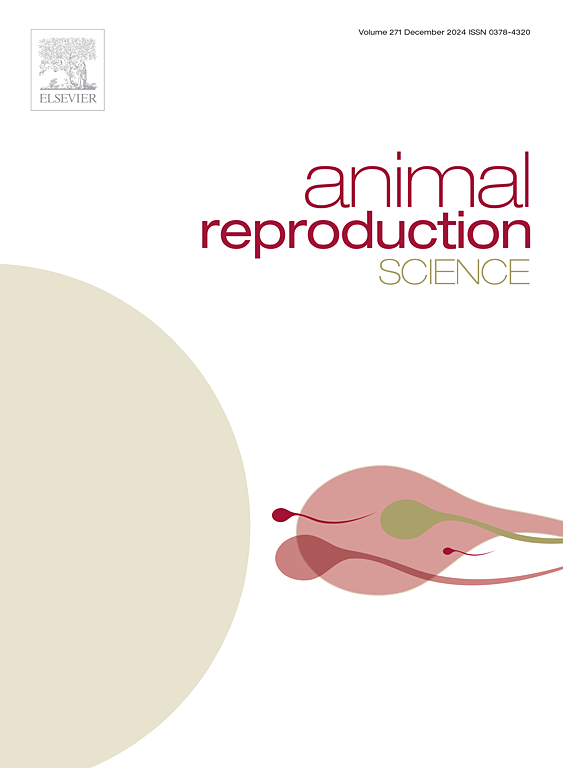基于母猪生育状况的循环小非编码RNA转录组分化
IF 3.3
2区 农林科学
Q1 AGRICULTURE, DAIRY & ANIMAL SCIENCE
引用次数: 0
摘要
母猪的繁殖性能对养猪业的生产力至关重要。然而,由于遗传力低和不利的遗传相关性,生殖和凋落性状的遗传改良仍然具有挑战性。整合小非编码(sncRNA)生物标志物来补充现有的选择方案可能会提高母猪的生殖潜力选择。本研究旨在比较不育(INF;连续两次人工授精后未怀孕,n = 30)和高生殖潜力(HRP;平均一生活产仔数≥13头仔猪,n = 50头)母猪,并鉴定与生殖潜能相关的候选miRNA生物标志物。小RNA测序结果显示,19个显著(P <; 0.05)差异表达的sncrna(12个在INF中上调,7个在INF中下调)和13个显著(P <; 0.05)差异表达的mirna(8个在INF中上调,5个在INF中下调)。许多已鉴定的demirna在雌性繁殖和不育中具有已知的作用,然而,这些差异是母猪生殖潜能水平的因果反应还是代偿反应尚不清楚。使用互补特征选择方法,选择了22个候选miRNA生物标志物,包括miR-140-3p, miR-215-5p和miR-7142-3p。训练后的支持向量机(SVM)对母猪生殖潜能的分类准确率(91 %)高,对HRP的敏感性(96 %)高,对INF的特异性(83 %)高,支持其在种猪群体中提高生殖潜能选择效率的潜力。为了确定这22个候选miRNA生物标志物和模型在农场种猪群选择中的普遍性和实际应用,有必要在更大的、独立的母猪队列中进行验证。本文章由计算机程序翻译,如有差异,请以英文原文为准。
Divergence in the circulating small non-coding RNA transcriptome based on female pig fertility status
The reproductive performance of sows is critical to pork industry productivity. However, genetic improvement of reproductive and litter traits remains challenging due to low heritability and unfavourable genetic correlations. Integrating small non-coding (sncRNA) biomarkers to supplement existing selection protocols may enhance female pig reproductive potential selection. This study aimed to compare circulating serum sncRNA profiles between infertile (INF; nonpregnant after two consecutive artificial inseminations, n = 30) and high reproductive potential (HRP; average lifetime live litter size ≥ 13 piglets, n = 50) female pigs and identify candidate miRNA biomarkers associated with reproductive potential. Small RNA sequencing revealed 19 significantly (P < 0.05) different expressed sncRNAs (12 upregulated and 7 downregulated in INF) and 13 significantly (P < 0.05) different expressed miRNAs (8 upregulated and 5 downregulated in INF). Many of the identified DEmiRNAs have known roles in female reproduction and infertility, however, whether these differences are causal or compensatory responses of female pig reproductive potential level remains unclear. Using a complementary feature selection approach, 22 candidate miRNA biomarkers were selected, including miR-140-3p, miR-215-5p, and miR-7142-3p. The trained support vector machine (SVM) classified female pig reproductive potential with high accuracy (91 %), sensitivity for HRP (96 %) and specificity for INF (83 %), supporting its potential to improve selection efficiency of reproductive potential in the breeding herd. Validation of these 22 candidate miRNA biomarkers and model in a larger, independent cohort of female pigs is necessary to determine generalizability and use for practical application in on-farm breeding herd selection.
求助全文
通过发布文献求助,成功后即可免费获取论文全文。
去求助
来源期刊

Animal Reproduction Science
农林科学-奶制品与动物科学
CiteScore
4.50
自引率
9.10%
发文量
136
审稿时长
54 days
期刊介绍:
Animal Reproduction Science publishes results from studies relating to reproduction and fertility in animals. This includes both fundamental research and applied studies, including management practices that increase our understanding of the biology and manipulation of reproduction. Manuscripts should go into depth in the mechanisms involved in the research reported, rather than a give a mere description of findings. The focus is on animals that are useful to humans including food- and fibre-producing; companion/recreational; captive; and endangered species including zoo animals, but excluding laboratory animals unless the results of the study provide new information that impacts the basic understanding of the biology or manipulation of reproduction.
The journal''s scope includes the study of reproductive physiology and endocrinology, reproductive cycles, natural and artificial control of reproduction, preservation and use of gametes and embryos, pregnancy and parturition, infertility and sterility, diagnostic and therapeutic techniques.
The Editorial Board of Animal Reproduction Science has decided not to publish papers in which there is an exclusive examination of the in vitro development of oocytes and embryos; however, there will be consideration of papers that include in vitro studies where the source of the oocytes and/or development of the embryos beyond the blastocyst stage is part of the experimental design.
 求助内容:
求助内容: 应助结果提醒方式:
应助结果提醒方式:


